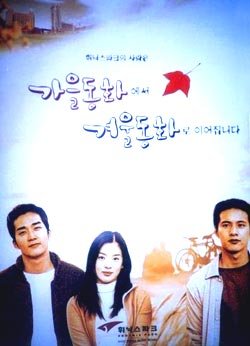Fall in Love with Korea's Danpung Season
Published on | Source
Every fall, there is a mass movement across the country, and I'm not talking about the geese.
Advertisement
In Korea, families, couples, hikers and photographers make up part of the diverse group of tourists setting out for a danpung yeohaeng, or a trip to see the changing of the leaves. (Danpung is changing of the leaves and yeohaeng means trip or vacation)
We've written a post about what to enjoy about summer in Korea and we should be writing one soon about the winter (the ondol, or heated floor, system here is fascinating!). Each season holds a special place for Korean people and culture.
As in many cultures, fall is thought of as a romantic season here; a time to literally fall in love and snag up a significant other in time for the winter holidays. One of the most popular Korean dramas to date, "Autumn in my Heart" takes place during this season, nodding to this notion of fall romance. This phrase can be heard a lot throughout the season: Ga-eul-tahn-dah, or roughly translated as feeling sentimental during the fall. Fall gives way to feelings of nostalgia and longing.

Autumn in Korea typically lasts from about September to November and includes Chuseok, the most important of Korean holidays. Right now is the peak of fall and the perfect time to see the vibrant colors that pepper the mountainous regions of the country.
I had never fully appreciated the beauty of fall before coming to Korea. The mild days and clear skies make it the best time of year to visit the country. The scorching humidity of the summer monsoon season is over and it's just before white frost begins to settle in.
Gangwondo, on the eastern side of the peninsula, is a popular site for viewing the danpung. I make sure to go every year for the best view of the variegated vegetation that makes up the landscape. Even though I'm a novice photographer, these leaves are models without imperfections. It's impossible not to get a great shot:
Seoraksan, or Mt. Seorak, is arguably the most visited spot during this season, as it offers up fresh air and the brilliant foliage. Visitors can take a cable car up the mountain for a breathtaking panoramic view.
According to the Korea Tourism Organization, the mountain was named Seorak (Seol meaning snow and Ak meaning big mountain) because the snow would not melt for a long time, keeping the rocks in a permanent state of white. In November 1965, the Seorak Mountain district was designated as a Natural Monument preservation area. In December 1973, it was designated as a park preservation area, and in August 1982, as a Biosphere Preservation District by UNESCO. The site even recommends separate autumn foliage courses to best experience the danpung.
About the author by Donna Choi
Born and raised in the States, I came to Seoul in 2009 and have loved living and working in such a high-tech and connected city ever since. I enjoy collecting unique, cute gadgets/items (I have a bread-scented smartphone case!) and traveling around Korea. My personal mission while living in Korea: Try every type of Korean food known to exist.
- Follow @advancedtechkr Twitter
- https://www.facebook.com/AdvancedTechKOR


